MNG93002 - Strategic Analysis: Case Study of the US Airline Industry
VerifiedAdded on 2023/06/13
|16
|4045
|141
Report
AI Summary
This report provides a comprehensive analysis of the US airline industry, employing Porter's Five Forces model to evaluate its competitive landscape and identify factors influencing profitability. It begins with an overview of the industry, highlighting key players and the impact of price wars and rising fuel costs. The report then delves into a detailed examination of each of Porter's Five Forces – the threat of new entrants, bargaining power of buyers and suppliers, the threat of substitutes, and industry rivalry – assessing their influence on the industry. Advantages and disadvantages of using the Five Forces model are discussed, followed by an analysis of the industry's economic performance, noting its cyclical nature and sensitivity to economic conditions. The report concludes by suggesting strategies airlines can adopt to enhance persistent profitability, considering the challenges and opportunities identified throughout the analysis. This report uses course code MNG93002 Strategy and Case Analysis as reference.
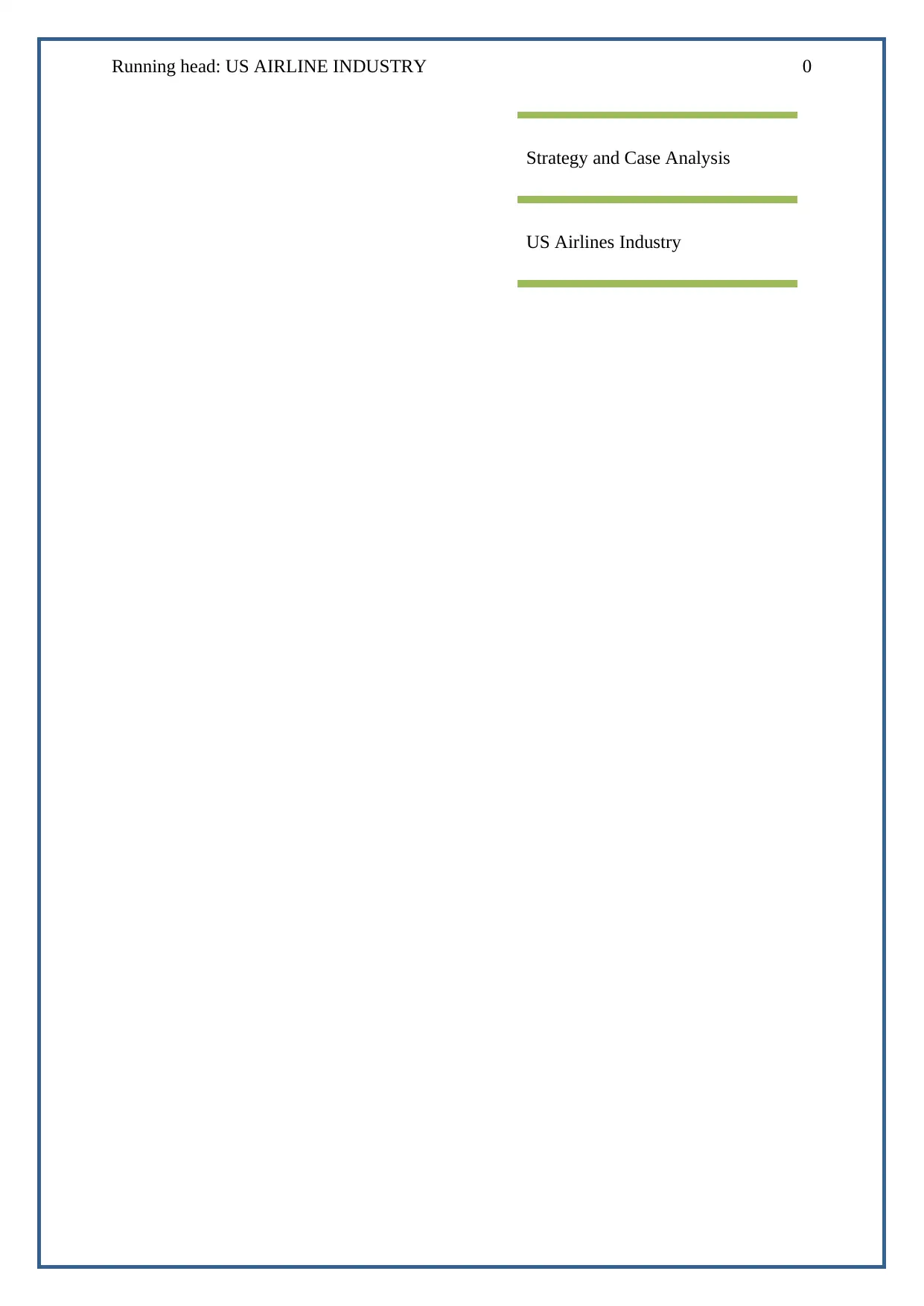
Running head: US AIRLINE INDUSTRY 0
Strategy and Case Analysis
US Airlines Industry
Strategy and Case Analysis
US Airlines Industry
Paraphrase This Document
Need a fresh take? Get an instant paraphrase of this document with our AI Paraphraser
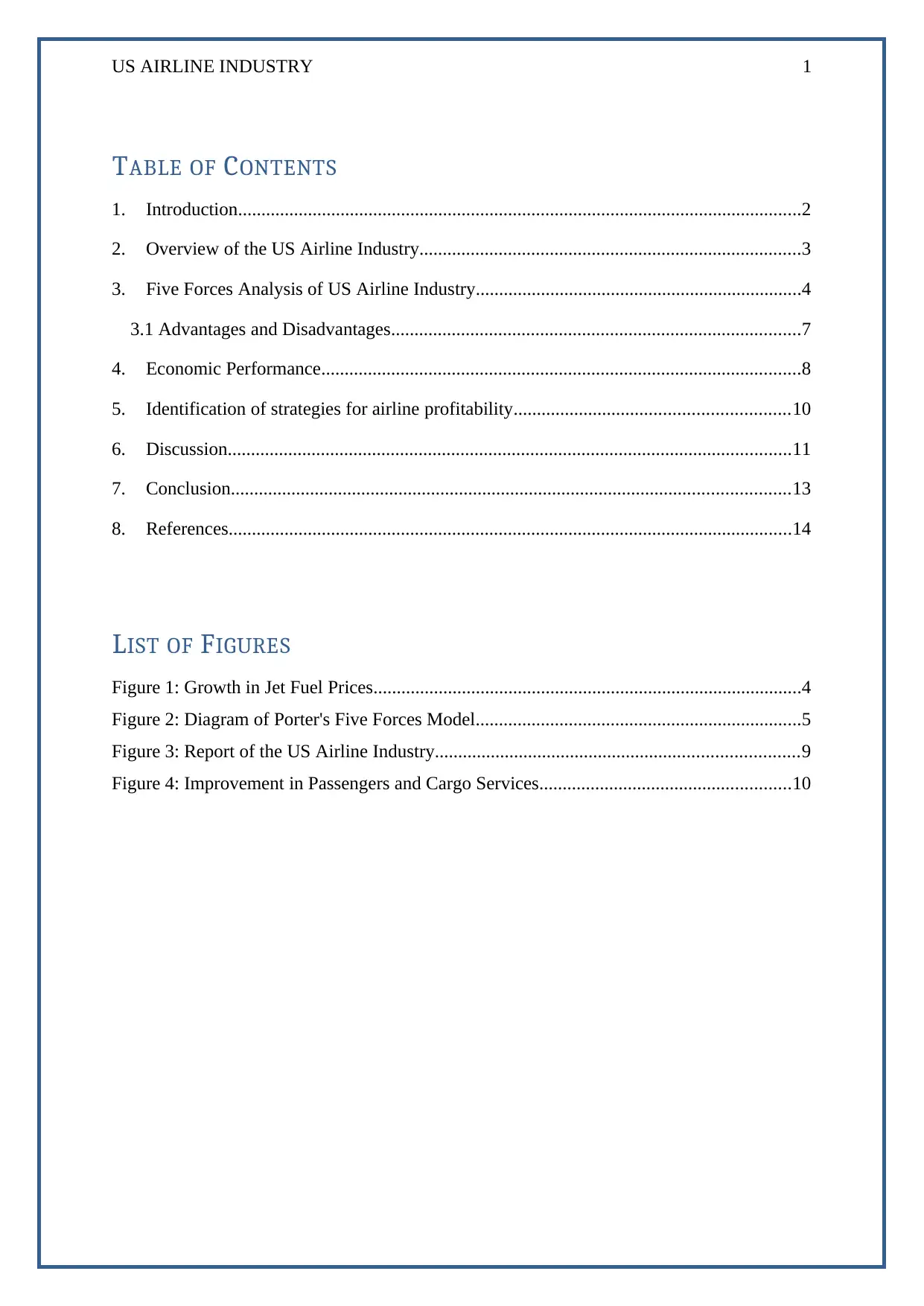
US AIRLINE INDUSTRY 1
TABLE OF CONTENTS
1. Introduction.........................................................................................................................2
2. Overview of the US Airline Industry..................................................................................3
3. Five Forces Analysis of US Airline Industry......................................................................4
3.1 Advantages and Disadvantages........................................................................................7
4. Economic Performance.......................................................................................................8
5. Identification of strategies for airline profitability...........................................................10
6. Discussion.........................................................................................................................11
7. Conclusion........................................................................................................................13
8. References.........................................................................................................................14
LIST OF FIGURES
Figure 1: Growth in Jet Fuel Prices............................................................................................4
Figure 2: Diagram of Porter's Five Forces Model......................................................................5
Figure 3: Report of the US Airline Industry..............................................................................9
Figure 4: Improvement in Passengers and Cargo Services......................................................10
TABLE OF CONTENTS
1. Introduction.........................................................................................................................2
2. Overview of the US Airline Industry..................................................................................3
3. Five Forces Analysis of US Airline Industry......................................................................4
3.1 Advantages and Disadvantages........................................................................................7
4. Economic Performance.......................................................................................................8
5. Identification of strategies for airline profitability...........................................................10
6. Discussion.........................................................................................................................11
7. Conclusion........................................................................................................................13
8. References.........................................................................................................................14
LIST OF FIGURES
Figure 1: Growth in Jet Fuel Prices............................................................................................4
Figure 2: Diagram of Porter's Five Forces Model......................................................................5
Figure 3: Report of the US Airline Industry..............................................................................9
Figure 4: Improvement in Passengers and Cargo Services......................................................10
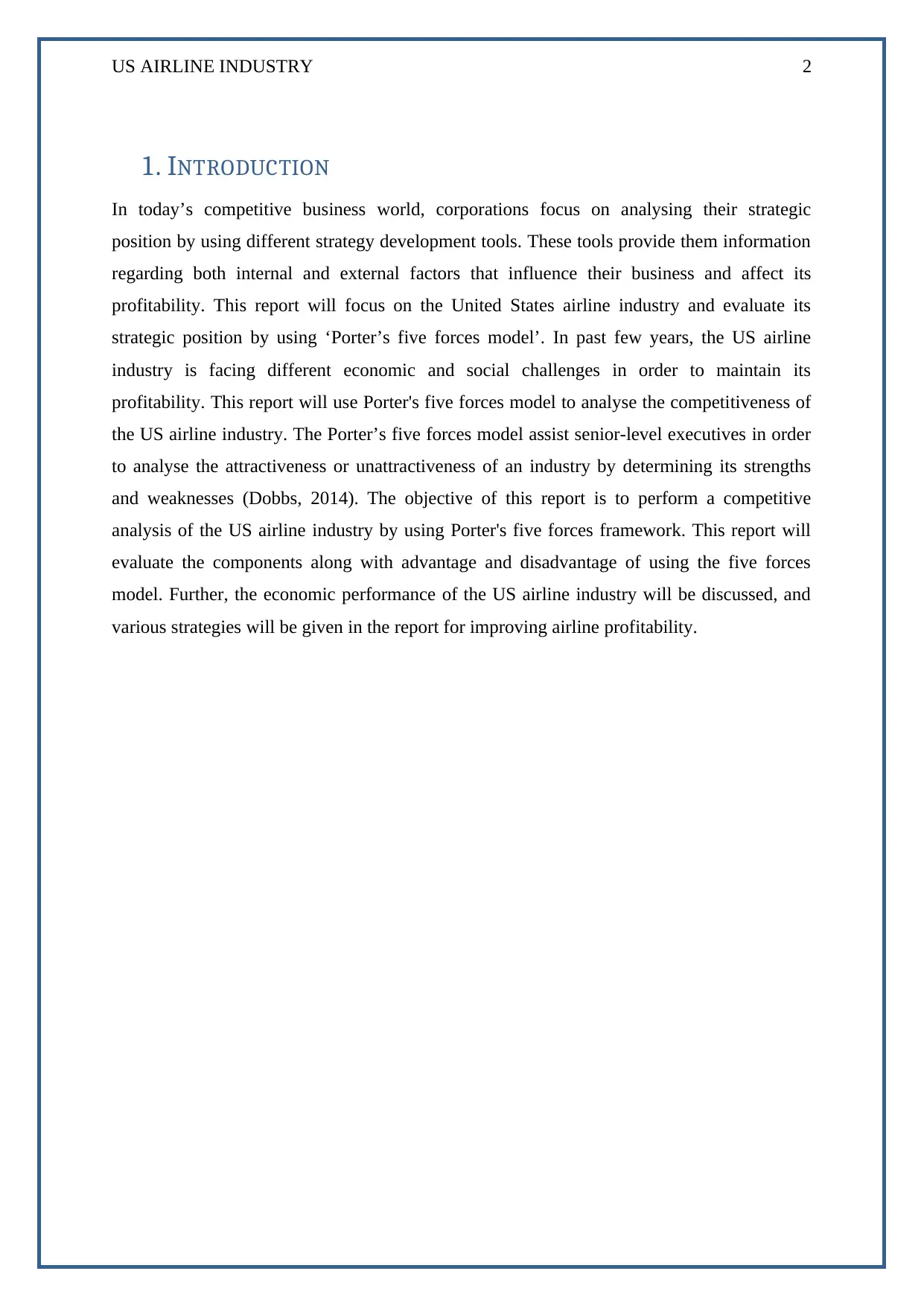
US AIRLINE INDUSTRY 2
1. INTRODUCTION
In today’s competitive business world, corporations focus on analysing their strategic
position by using different strategy development tools. These tools provide them information
regarding both internal and external factors that influence their business and affect its
profitability. This report will focus on the United States airline industry and evaluate its
strategic position by using ‘Porter’s five forces model’. In past few years, the US airline
industry is facing different economic and social challenges in order to maintain its
profitability. This report will use Porter's five forces model to analyse the competitiveness of
the US airline industry. The Porter’s five forces model assist senior-level executives in order
to analyse the attractiveness or unattractiveness of an industry by determining its strengths
and weaknesses (Dobbs, 2014). The objective of this report is to perform a competitive
analysis of the US airline industry by using Porter's five forces framework. This report will
evaluate the components along with advantage and disadvantage of using the five forces
model. Further, the economic performance of the US airline industry will be discussed, and
various strategies will be given in the report for improving airline profitability.
1. INTRODUCTION
In today’s competitive business world, corporations focus on analysing their strategic
position by using different strategy development tools. These tools provide them information
regarding both internal and external factors that influence their business and affect its
profitability. This report will focus on the United States airline industry and evaluate its
strategic position by using ‘Porter’s five forces model’. In past few years, the US airline
industry is facing different economic and social challenges in order to maintain its
profitability. This report will use Porter's five forces model to analyse the competitiveness of
the US airline industry. The Porter’s five forces model assist senior-level executives in order
to analyse the attractiveness or unattractiveness of an industry by determining its strengths
and weaknesses (Dobbs, 2014). The objective of this report is to perform a competitive
analysis of the US airline industry by using Porter's five forces framework. This report will
evaluate the components along with advantage and disadvantage of using the five forces
model. Further, the economic performance of the US airline industry will be discussed, and
various strategies will be given in the report for improving airline profitability.
⊘ This is a preview!⊘
Do you want full access?
Subscribe today to unlock all pages.

Trusted by 1+ million students worldwide
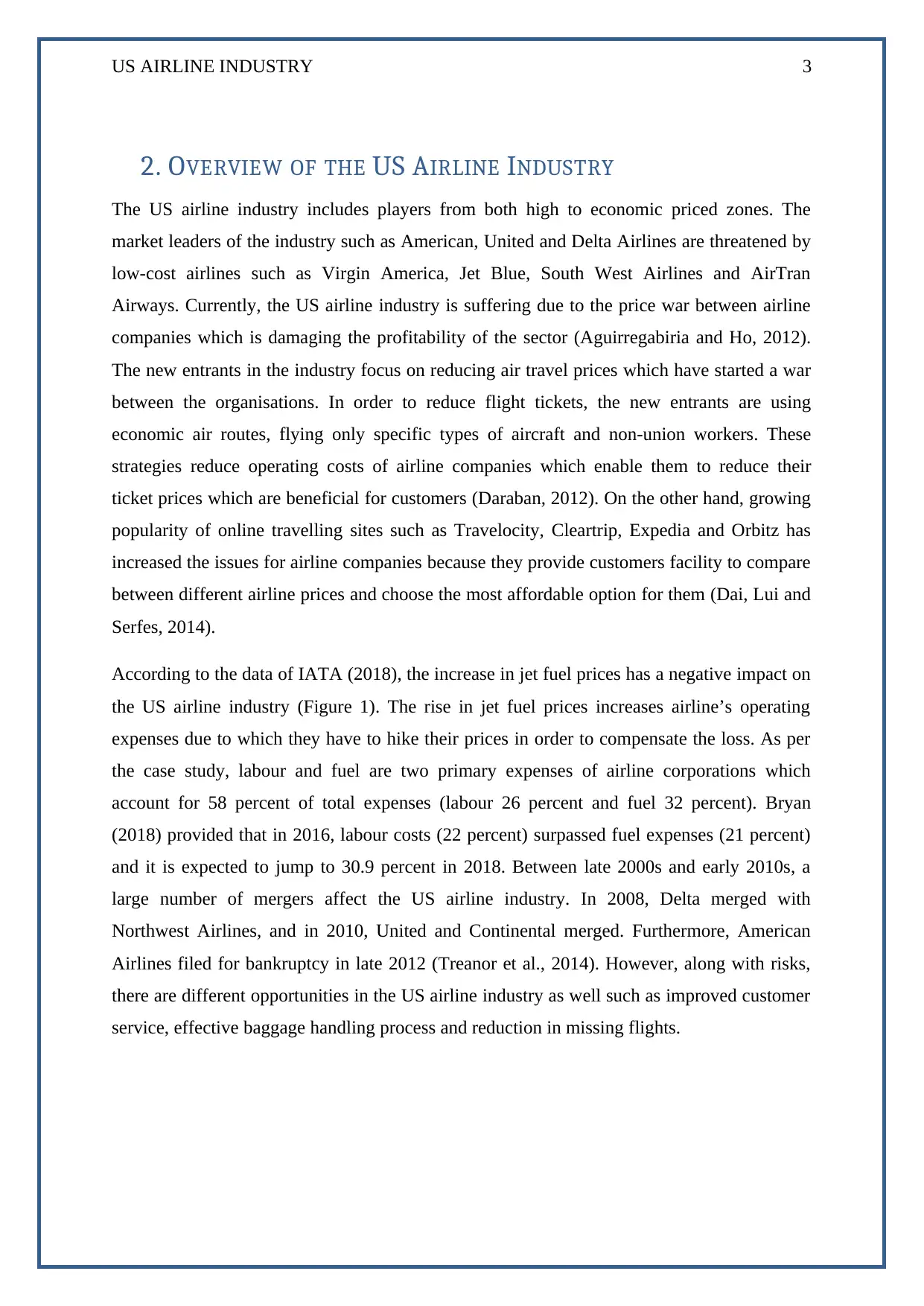
US AIRLINE INDUSTRY 3
2. OVERVIEW OF THE US AIRLINE INDUSTRY
The US airline industry includes players from both high to economic priced zones. The
market leaders of the industry such as American, United and Delta Airlines are threatened by
low-cost airlines such as Virgin America, Jet Blue, South West Airlines and AirTran
Airways. Currently, the US airline industry is suffering due to the price war between airline
companies which is damaging the profitability of the sector (Aguirregabiria and Ho, 2012).
The new entrants in the industry focus on reducing air travel prices which have started a war
between the organisations. In order to reduce flight tickets, the new entrants are using
economic air routes, flying only specific types of aircraft and non-union workers. These
strategies reduce operating costs of airline companies which enable them to reduce their
ticket prices which are beneficial for customers (Daraban, 2012). On the other hand, growing
popularity of online travelling sites such as Travelocity, Cleartrip, Expedia and Orbitz has
increased the issues for airline companies because they provide customers facility to compare
between different airline prices and choose the most affordable option for them (Dai, Lui and
Serfes, 2014).
According to the data of IATA (2018), the increase in jet fuel prices has a negative impact on
the US airline industry (Figure 1). The rise in jet fuel prices increases airline’s operating
expenses due to which they have to hike their prices in order to compensate the loss. As per
the case study, labour and fuel are two primary expenses of airline corporations which
account for 58 percent of total expenses (labour 26 percent and fuel 32 percent). Bryan
(2018) provided that in 2016, labour costs (22 percent) surpassed fuel expenses (21 percent)
and it is expected to jump to 30.9 percent in 2018. Between late 2000s and early 2010s, a
large number of mergers affect the US airline industry. In 2008, Delta merged with
Northwest Airlines, and in 2010, United and Continental merged. Furthermore, American
Airlines filed for bankruptcy in late 2012 (Treanor et al., 2014). However, along with risks,
there are different opportunities in the US airline industry as well such as improved customer
service, effective baggage handling process and reduction in missing flights.
2. OVERVIEW OF THE US AIRLINE INDUSTRY
The US airline industry includes players from both high to economic priced zones. The
market leaders of the industry such as American, United and Delta Airlines are threatened by
low-cost airlines such as Virgin America, Jet Blue, South West Airlines and AirTran
Airways. Currently, the US airline industry is suffering due to the price war between airline
companies which is damaging the profitability of the sector (Aguirregabiria and Ho, 2012).
The new entrants in the industry focus on reducing air travel prices which have started a war
between the organisations. In order to reduce flight tickets, the new entrants are using
economic air routes, flying only specific types of aircraft and non-union workers. These
strategies reduce operating costs of airline companies which enable them to reduce their
ticket prices which are beneficial for customers (Daraban, 2012). On the other hand, growing
popularity of online travelling sites such as Travelocity, Cleartrip, Expedia and Orbitz has
increased the issues for airline companies because they provide customers facility to compare
between different airline prices and choose the most affordable option for them (Dai, Lui and
Serfes, 2014).
According to the data of IATA (2018), the increase in jet fuel prices has a negative impact on
the US airline industry (Figure 1). The rise in jet fuel prices increases airline’s operating
expenses due to which they have to hike their prices in order to compensate the loss. As per
the case study, labour and fuel are two primary expenses of airline corporations which
account for 58 percent of total expenses (labour 26 percent and fuel 32 percent). Bryan
(2018) provided that in 2016, labour costs (22 percent) surpassed fuel expenses (21 percent)
and it is expected to jump to 30.9 percent in 2018. Between late 2000s and early 2010s, a
large number of mergers affect the US airline industry. In 2008, Delta merged with
Northwest Airlines, and in 2010, United and Continental merged. Furthermore, American
Airlines filed for bankruptcy in late 2012 (Treanor et al., 2014). However, along with risks,
there are different opportunities in the US airline industry as well such as improved customer
service, effective baggage handling process and reduction in missing flights.
Paraphrase This Document
Need a fresh take? Get an instant paraphrase of this document with our AI Paraphraser
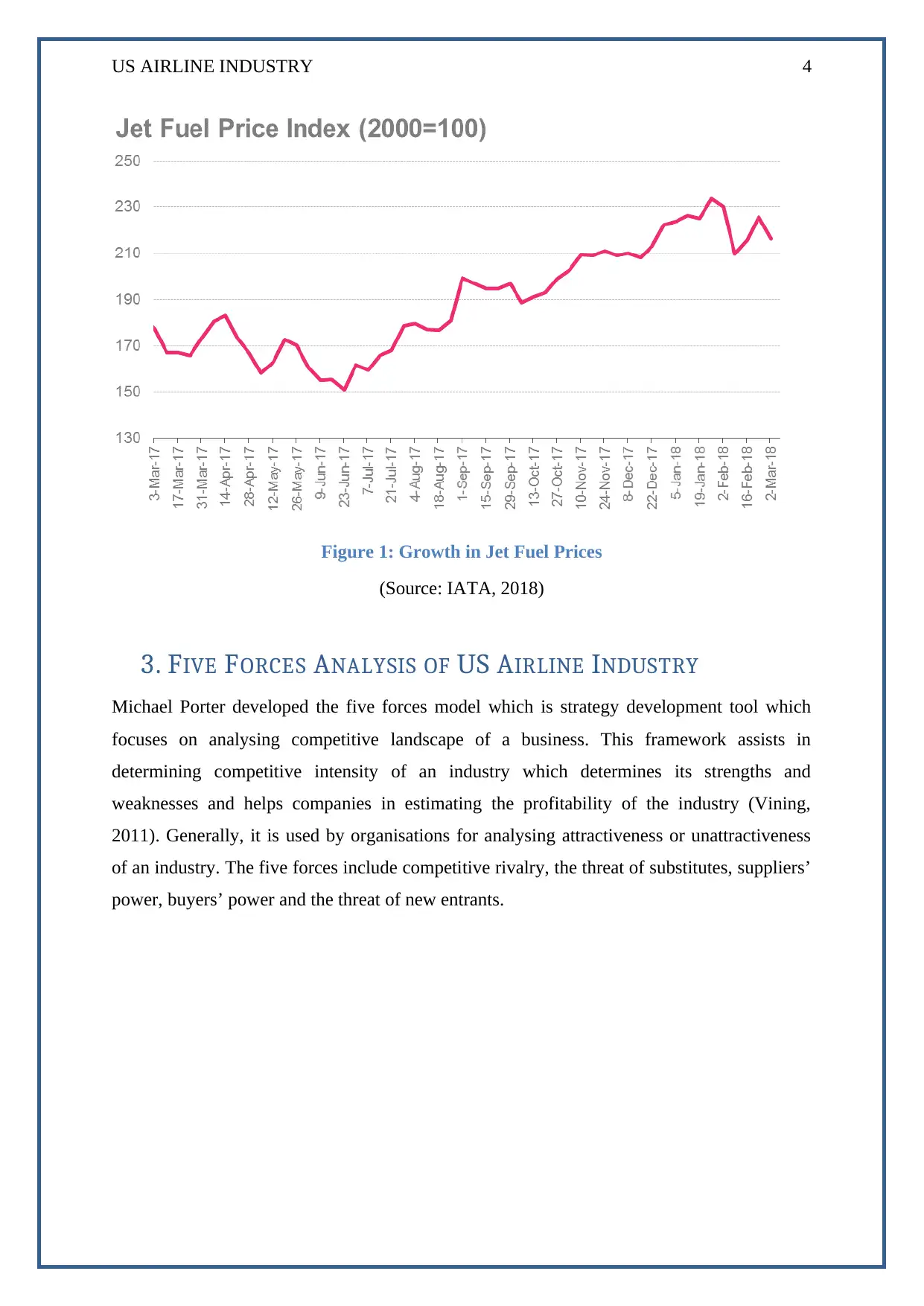
US AIRLINE INDUSTRY 4
Figure 1: Growth in Jet Fuel Prices
(Source: IATA, 2018)
3. FIVE FORCES ANALYSIS OF US AIRLINE INDUSTRY
Michael Porter developed the five forces model which is strategy development tool which
focuses on analysing competitive landscape of a business. This framework assists in
determining competitive intensity of an industry which determines its strengths and
weaknesses and helps companies in estimating the profitability of the industry (Vining,
2011). Generally, it is used by organisations for analysing attractiveness or unattractiveness
of an industry. The five forces include competitive rivalry, the threat of substitutes, suppliers’
power, buyers’ power and the threat of new entrants.
Figure 1: Growth in Jet Fuel Prices
(Source: IATA, 2018)
3. FIVE FORCES ANALYSIS OF US AIRLINE INDUSTRY
Michael Porter developed the five forces model which is strategy development tool which
focuses on analysing competitive landscape of a business. This framework assists in
determining competitive intensity of an industry which determines its strengths and
weaknesses and helps companies in estimating the profitability of the industry (Vining,
2011). Generally, it is used by organisations for analysing attractiveness or unattractiveness
of an industry. The five forces include competitive rivalry, the threat of substitutes, suppliers’
power, buyers’ power and the threat of new entrants.
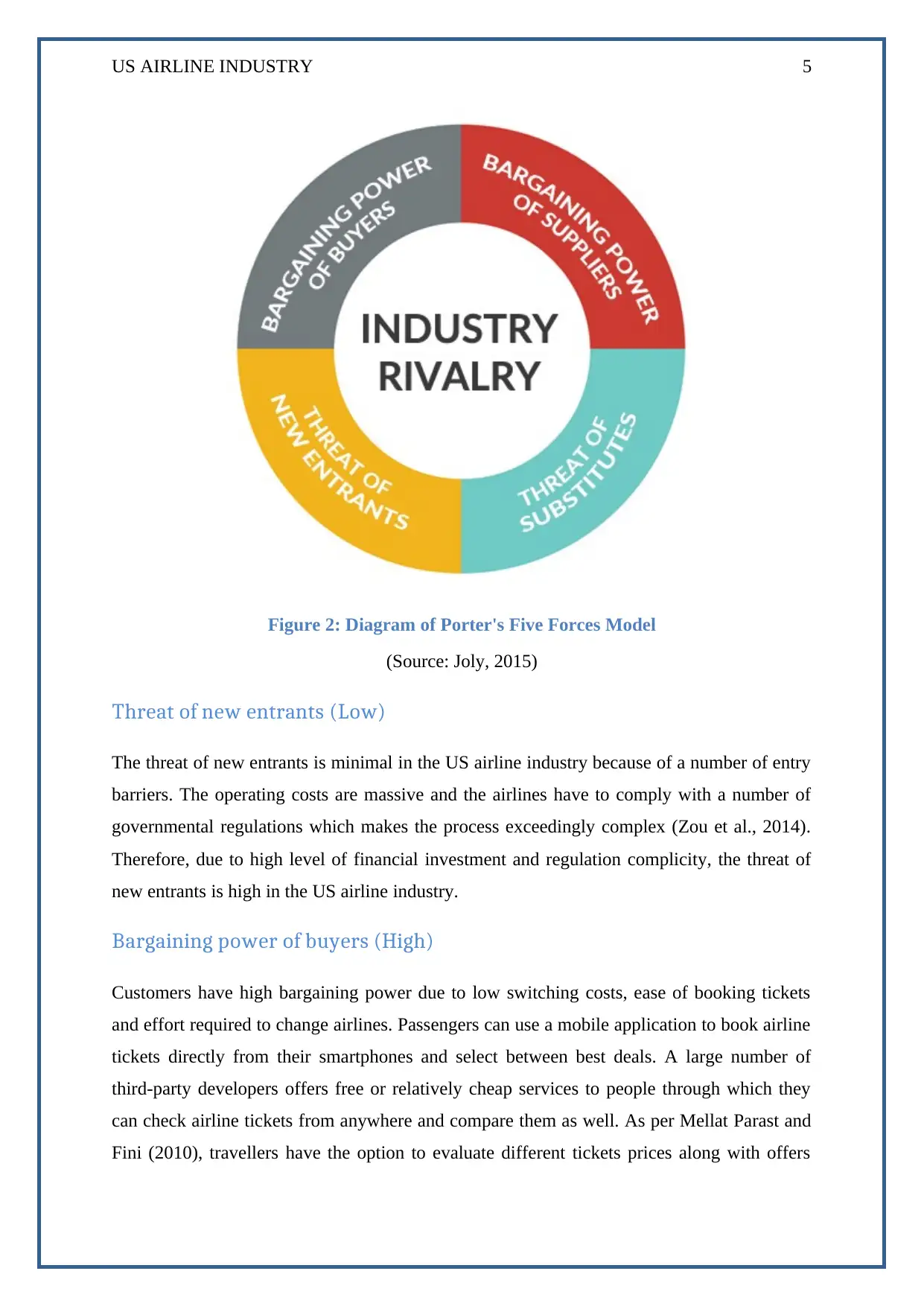
US AIRLINE INDUSTRY 5
Figure 2: Diagram of Porter's Five Forces Model
(Source: Joly, 2015)
Threat of new entrants (Low)
The threat of new entrants is minimal in the US airline industry because of a number of entry
barriers. The operating costs are massive and the airlines have to comply with a number of
governmental regulations which makes the process exceedingly complex (Zou et al., 2014).
Therefore, due to high level of financial investment and regulation complicity, the threat of
new entrants is high in the US airline industry.
Bargaining power of buyers (High)
Customers have high bargaining power due to low switching costs, ease of booking tickets
and effort required to change airlines. Passengers can use a mobile application to book airline
tickets directly from their smartphones and select between best deals. A large number of
third-party developers offers free or relatively cheap services to people through which they
can check airline tickets from anywhere and compare them as well. As per Mellat Parast and
Fini (2010), travellers have the option to evaluate different tickets prices along with offers
Figure 2: Diagram of Porter's Five Forces Model
(Source: Joly, 2015)
Threat of new entrants (Low)
The threat of new entrants is minimal in the US airline industry because of a number of entry
barriers. The operating costs are massive and the airlines have to comply with a number of
governmental regulations which makes the process exceedingly complex (Zou et al., 2014).
Therefore, due to high level of financial investment and regulation complicity, the threat of
new entrants is high in the US airline industry.
Bargaining power of buyers (High)
Customers have high bargaining power due to low switching costs, ease of booking tickets
and effort required to change airlines. Passengers can use a mobile application to book airline
tickets directly from their smartphones and select between best deals. A large number of
third-party developers offers free or relatively cheap services to people through which they
can check airline tickets from anywhere and compare them as well. As per Mellat Parast and
Fini (2010), travellers have the option to evaluate different tickets prices along with offers
⊘ This is a preview!⊘
Do you want full access?
Subscribe today to unlock all pages.

Trusted by 1+ million students worldwide
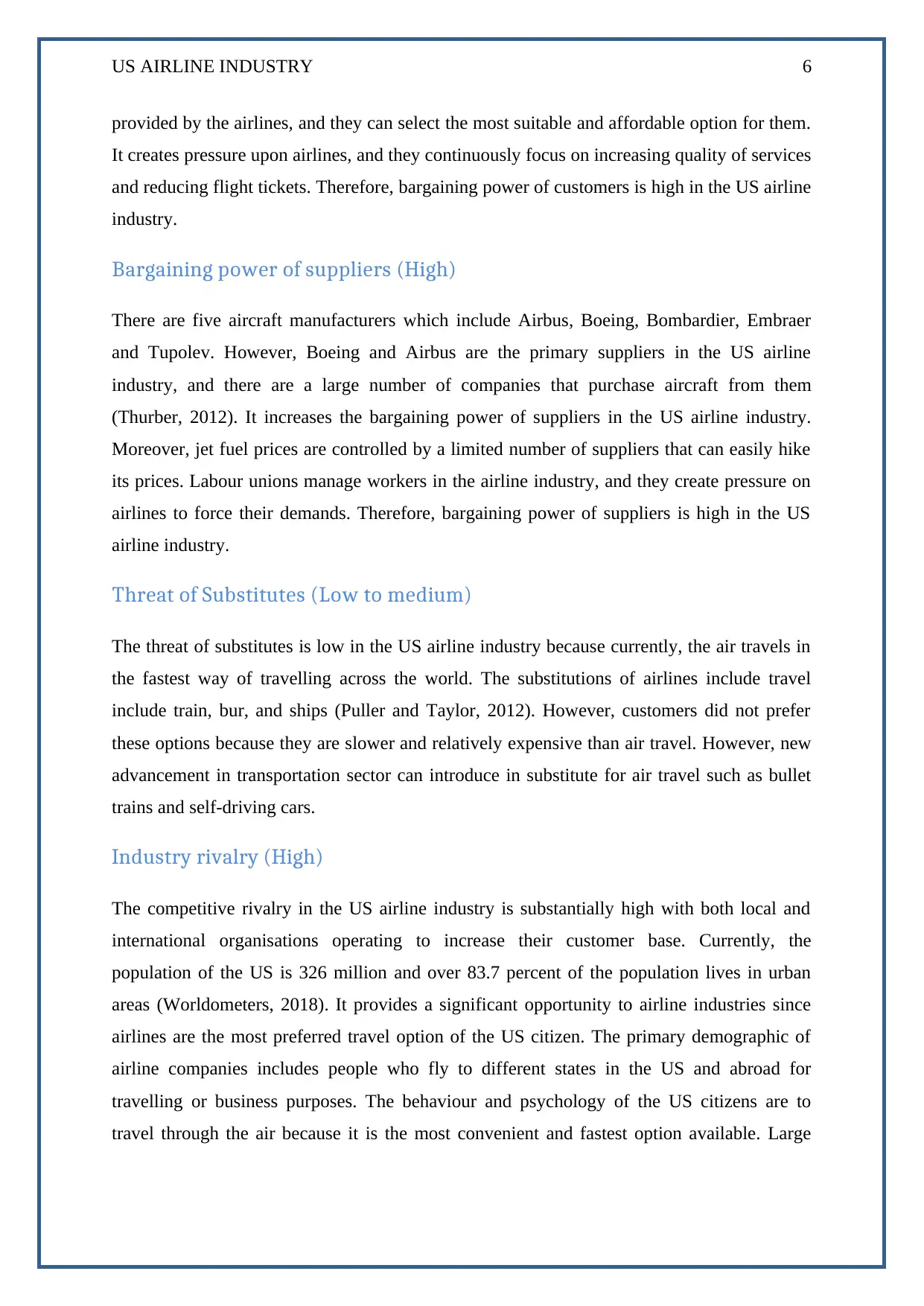
US AIRLINE INDUSTRY 6
provided by the airlines, and they can select the most suitable and affordable option for them.
It creates pressure upon airlines, and they continuously focus on increasing quality of services
and reducing flight tickets. Therefore, bargaining power of customers is high in the US airline
industry.
Bargaining power of suppliers (High)
There are five aircraft manufacturers which include Airbus, Boeing, Bombardier, Embraer
and Tupolev. However, Boeing and Airbus are the primary suppliers in the US airline
industry, and there are a large number of companies that purchase aircraft from them
(Thurber, 2012). It increases the bargaining power of suppliers in the US airline industry.
Moreover, jet fuel prices are controlled by a limited number of suppliers that can easily hike
its prices. Labour unions manage workers in the airline industry, and they create pressure on
airlines to force their demands. Therefore, bargaining power of suppliers is high in the US
airline industry.
Threat of Substitutes (Low to medium)
The threat of substitutes is low in the US airline industry because currently, the air travels in
the fastest way of travelling across the world. The substitutions of airlines include travel
include train, bur, and ships (Puller and Taylor, 2012). However, customers did not prefer
these options because they are slower and relatively expensive than air travel. However, new
advancement in transportation sector can introduce in substitute for air travel such as bullet
trains and self-driving cars.
Industry rivalry (High)
The competitive rivalry in the US airline industry is substantially high with both local and
international organisations operating to increase their customer base. Currently, the
population of the US is 326 million and over 83.7 percent of the population lives in urban
areas (Worldometers, 2018). It provides a significant opportunity to airline industries since
airlines are the most preferred travel option of the US citizen. The primary demographic of
airline companies includes people who fly to different states in the US and abroad for
travelling or business purposes. The behaviour and psychology of the US citizens are to
travel through the air because it is the most convenient and fastest option available. Large
provided by the airlines, and they can select the most suitable and affordable option for them.
It creates pressure upon airlines, and they continuously focus on increasing quality of services
and reducing flight tickets. Therefore, bargaining power of customers is high in the US airline
industry.
Bargaining power of suppliers (High)
There are five aircraft manufacturers which include Airbus, Boeing, Bombardier, Embraer
and Tupolev. However, Boeing and Airbus are the primary suppliers in the US airline
industry, and there are a large number of companies that purchase aircraft from them
(Thurber, 2012). It increases the bargaining power of suppliers in the US airline industry.
Moreover, jet fuel prices are controlled by a limited number of suppliers that can easily hike
its prices. Labour unions manage workers in the airline industry, and they create pressure on
airlines to force their demands. Therefore, bargaining power of suppliers is high in the US
airline industry.
Threat of Substitutes (Low to medium)
The threat of substitutes is low in the US airline industry because currently, the air travels in
the fastest way of travelling across the world. The substitutions of airlines include travel
include train, bur, and ships (Puller and Taylor, 2012). However, customers did not prefer
these options because they are slower and relatively expensive than air travel. However, new
advancement in transportation sector can introduce in substitute for air travel such as bullet
trains and self-driving cars.
Industry rivalry (High)
The competitive rivalry in the US airline industry is substantially high with both local and
international organisations operating to increase their customer base. Currently, the
population of the US is 326 million and over 83.7 percent of the population lives in urban
areas (Worldometers, 2018). It provides a significant opportunity to airline industries since
airlines are the most preferred travel option of the US citizen. The primary demographic of
airline companies includes people who fly to different states in the US and abroad for
travelling or business purposes. The behaviour and psychology of the US citizens are to
travel through the air because it is the most convenient and fastest option available. Large
Paraphrase This Document
Need a fresh take? Get an instant paraphrase of this document with our AI Paraphraser
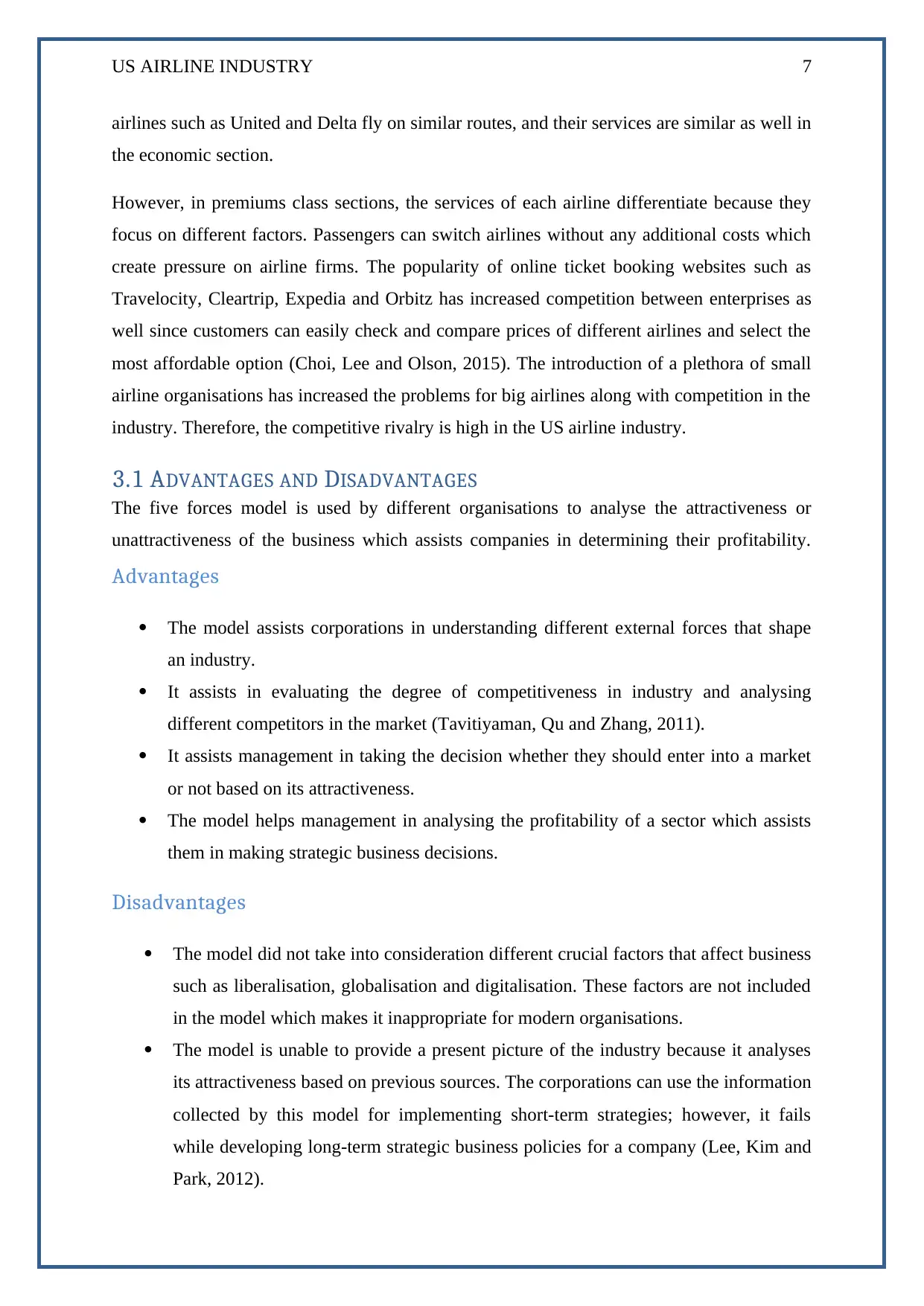
US AIRLINE INDUSTRY 7
airlines such as United and Delta fly on similar routes, and their services are similar as well in
the economic section.
However, in premiums class sections, the services of each airline differentiate because they
focus on different factors. Passengers can switch airlines without any additional costs which
create pressure on airline firms. The popularity of online ticket booking websites such as
Travelocity, Cleartrip, Expedia and Orbitz has increased competition between enterprises as
well since customers can easily check and compare prices of different airlines and select the
most affordable option (Choi, Lee and Olson, 2015). The introduction of a plethora of small
airline organisations has increased the problems for big airlines along with competition in the
industry. Therefore, the competitive rivalry is high in the US airline industry.
3.1 ADVANTAGES AND DISADVANTAGES
The five forces model is used by different organisations to analyse the attractiveness or
unattractiveness of the business which assists companies in determining their profitability.
Advantages
The model assists corporations in understanding different external forces that shape
an industry.
It assists in evaluating the degree of competitiveness in industry and analysing
different competitors in the market (Tavitiyaman, Qu and Zhang, 2011).
It assists management in taking the decision whether they should enter into a market
or not based on its attractiveness.
The model helps management in analysing the profitability of a sector which assists
them in making strategic business decisions.
Disadvantages
The model did not take into consideration different crucial factors that affect business
such as liberalisation, globalisation and digitalisation. These factors are not included
in the model which makes it inappropriate for modern organisations.
The model is unable to provide a present picture of the industry because it analyses
its attractiveness based on previous sources. The corporations can use the information
collected by this model for implementing short-term strategies; however, it fails
while developing long-term strategic business policies for a company (Lee, Kim and
Park, 2012).
airlines such as United and Delta fly on similar routes, and their services are similar as well in
the economic section.
However, in premiums class sections, the services of each airline differentiate because they
focus on different factors. Passengers can switch airlines without any additional costs which
create pressure on airline firms. The popularity of online ticket booking websites such as
Travelocity, Cleartrip, Expedia and Orbitz has increased competition between enterprises as
well since customers can easily check and compare prices of different airlines and select the
most affordable option (Choi, Lee and Olson, 2015). The introduction of a plethora of small
airline organisations has increased the problems for big airlines along with competition in the
industry. Therefore, the competitive rivalry is high in the US airline industry.
3.1 ADVANTAGES AND DISADVANTAGES
The five forces model is used by different organisations to analyse the attractiveness or
unattractiveness of the business which assists companies in determining their profitability.
Advantages
The model assists corporations in understanding different external forces that shape
an industry.
It assists in evaluating the degree of competitiveness in industry and analysing
different competitors in the market (Tavitiyaman, Qu and Zhang, 2011).
It assists management in taking the decision whether they should enter into a market
or not based on its attractiveness.
The model helps management in analysing the profitability of a sector which assists
them in making strategic business decisions.
Disadvantages
The model did not take into consideration different crucial factors that affect business
such as liberalisation, globalisation and digitalisation. These factors are not included
in the model which makes it inappropriate for modern organisations.
The model is unable to provide a present picture of the industry because it analyses
its attractiveness based on previous sources. The corporations can use the information
collected by this model for implementing short-term strategies; however, it fails
while developing long-term strategic business policies for a company (Lee, Kim and
Park, 2012).
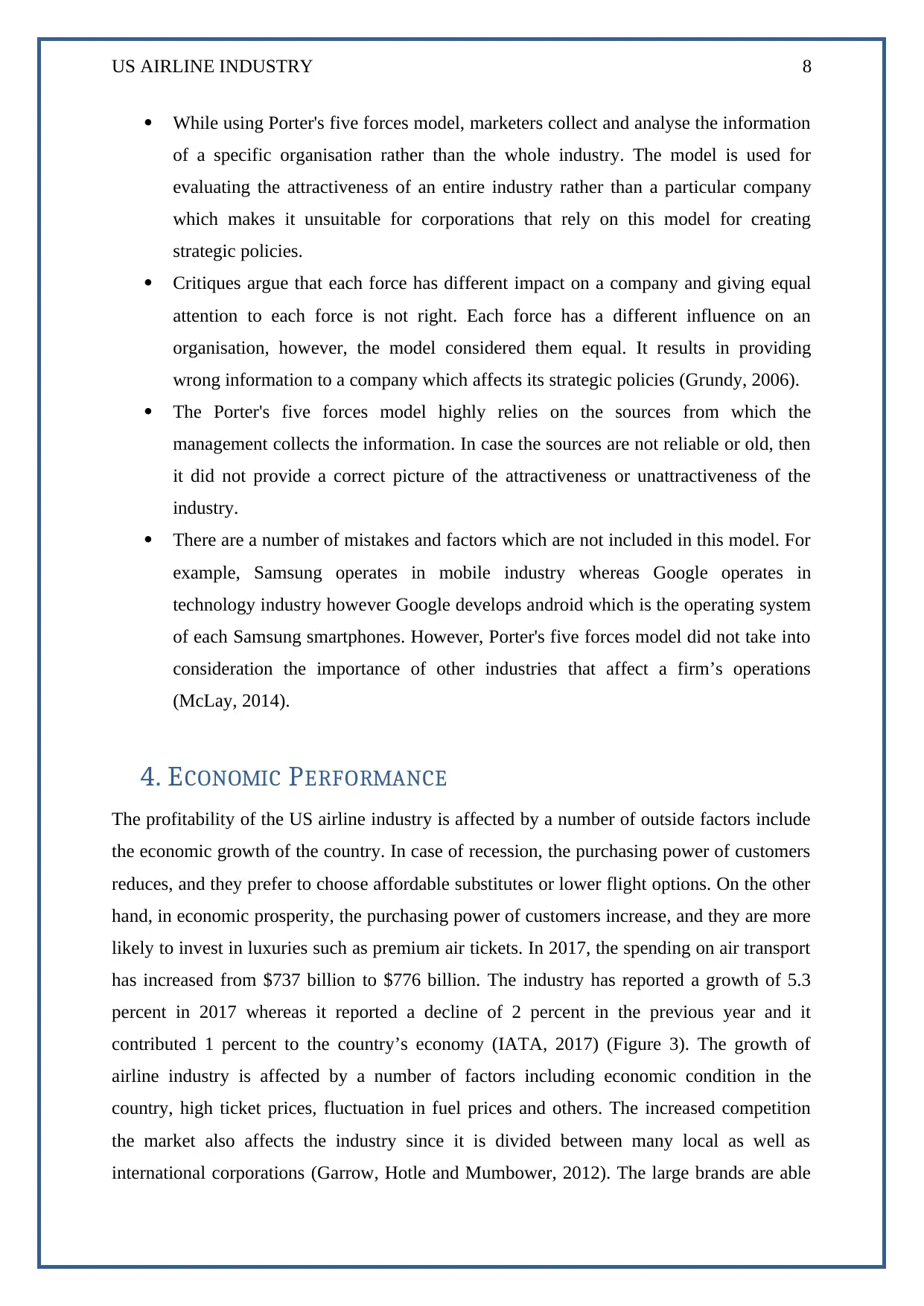
US AIRLINE INDUSTRY 8
While using Porter's five forces model, marketers collect and analyse the information
of a specific organisation rather than the whole industry. The model is used for
evaluating the attractiveness of an entire industry rather than a particular company
which makes it unsuitable for corporations that rely on this model for creating
strategic policies.
Critiques argue that each force has different impact on a company and giving equal
attention to each force is not right. Each force has a different influence on an
organisation, however, the model considered them equal. It results in providing
wrong information to a company which affects its strategic policies (Grundy, 2006).
The Porter's five forces model highly relies on the sources from which the
management collects the information. In case the sources are not reliable or old, then
it did not provide a correct picture of the attractiveness or unattractiveness of the
industry.
There are a number of mistakes and factors which are not included in this model. For
example, Samsung operates in mobile industry whereas Google operates in
technology industry however Google develops android which is the operating system
of each Samsung smartphones. However, Porter's five forces model did not take into
consideration the importance of other industries that affect a firm’s operations
(McLay, 2014).
4. ECONOMIC PERFORMANCE
The profitability of the US airline industry is affected by a number of outside factors include
the economic growth of the country. In case of recession, the purchasing power of customers
reduces, and they prefer to choose affordable substitutes or lower flight options. On the other
hand, in economic prosperity, the purchasing power of customers increase, and they are more
likely to invest in luxuries such as premium air tickets. In 2017, the spending on air transport
has increased from $737 billion to $776 billion. The industry has reported a growth of 5.3
percent in 2017 whereas it reported a decline of 2 percent in the previous year and it
contributed 1 percent to the country’s economy (IATA, 2017) (Figure 3). The growth of
airline industry is affected by a number of factors including economic condition in the
country, high ticket prices, fluctuation in fuel prices and others. The increased competition
the market also affects the industry since it is divided between many local as well as
international corporations (Garrow, Hotle and Mumbower, 2012). The large brands are able
While using Porter's five forces model, marketers collect and analyse the information
of a specific organisation rather than the whole industry. The model is used for
evaluating the attractiveness of an entire industry rather than a particular company
which makes it unsuitable for corporations that rely on this model for creating
strategic policies.
Critiques argue that each force has different impact on a company and giving equal
attention to each force is not right. Each force has a different influence on an
organisation, however, the model considered them equal. It results in providing
wrong information to a company which affects its strategic policies (Grundy, 2006).
The Porter's five forces model highly relies on the sources from which the
management collects the information. In case the sources are not reliable or old, then
it did not provide a correct picture of the attractiveness or unattractiveness of the
industry.
There are a number of mistakes and factors which are not included in this model. For
example, Samsung operates in mobile industry whereas Google operates in
technology industry however Google develops android which is the operating system
of each Samsung smartphones. However, Porter's five forces model did not take into
consideration the importance of other industries that affect a firm’s operations
(McLay, 2014).
4. ECONOMIC PERFORMANCE
The profitability of the US airline industry is affected by a number of outside factors include
the economic growth of the country. In case of recession, the purchasing power of customers
reduces, and they prefer to choose affordable substitutes or lower flight options. On the other
hand, in economic prosperity, the purchasing power of customers increase, and they are more
likely to invest in luxuries such as premium air tickets. In 2017, the spending on air transport
has increased from $737 billion to $776 billion. The industry has reported a growth of 5.3
percent in 2017 whereas it reported a decline of 2 percent in the previous year and it
contributed 1 percent to the country’s economy (IATA, 2017) (Figure 3). The growth of
airline industry is affected by a number of factors including economic condition in the
country, high ticket prices, fluctuation in fuel prices and others. The increased competition
the market also affects the industry since it is divided between many local as well as
international corporations (Garrow, Hotle and Mumbower, 2012). The large brands are able
⊘ This is a preview!⊘
Do you want full access?
Subscribe today to unlock all pages.

Trusted by 1+ million students worldwide
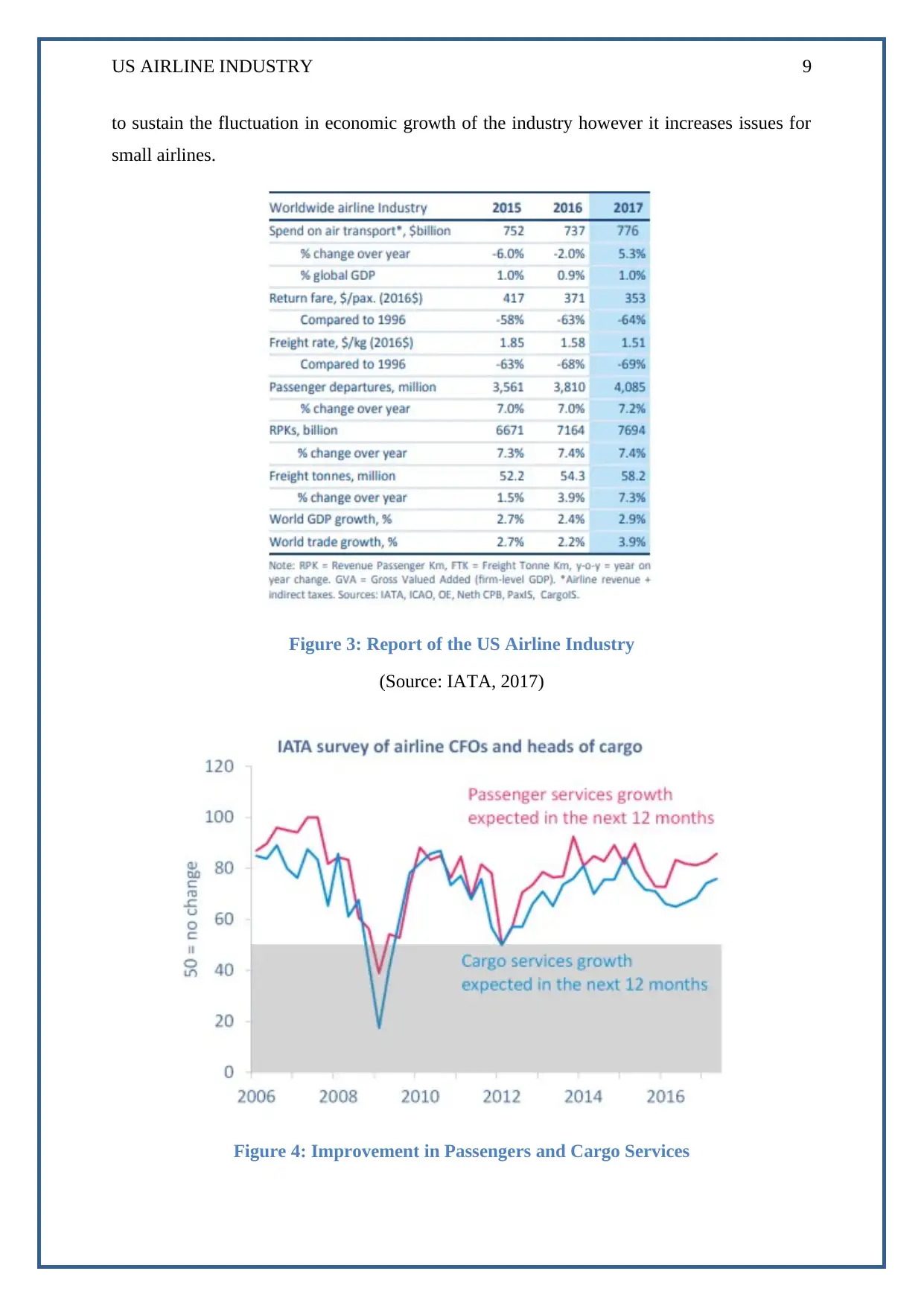
US AIRLINE INDUSTRY 9
to sustain the fluctuation in economic growth of the industry however it increases issues for
small airlines.
Figure 3: Report of the US Airline Industry
(Source: IATA, 2017)
Figure 4: Improvement in Passengers and Cargo Services
to sustain the fluctuation in economic growth of the industry however it increases issues for
small airlines.
Figure 3: Report of the US Airline Industry
(Source: IATA, 2017)
Figure 4: Improvement in Passengers and Cargo Services
Paraphrase This Document
Need a fresh take? Get an instant paraphrase of this document with our AI Paraphraser
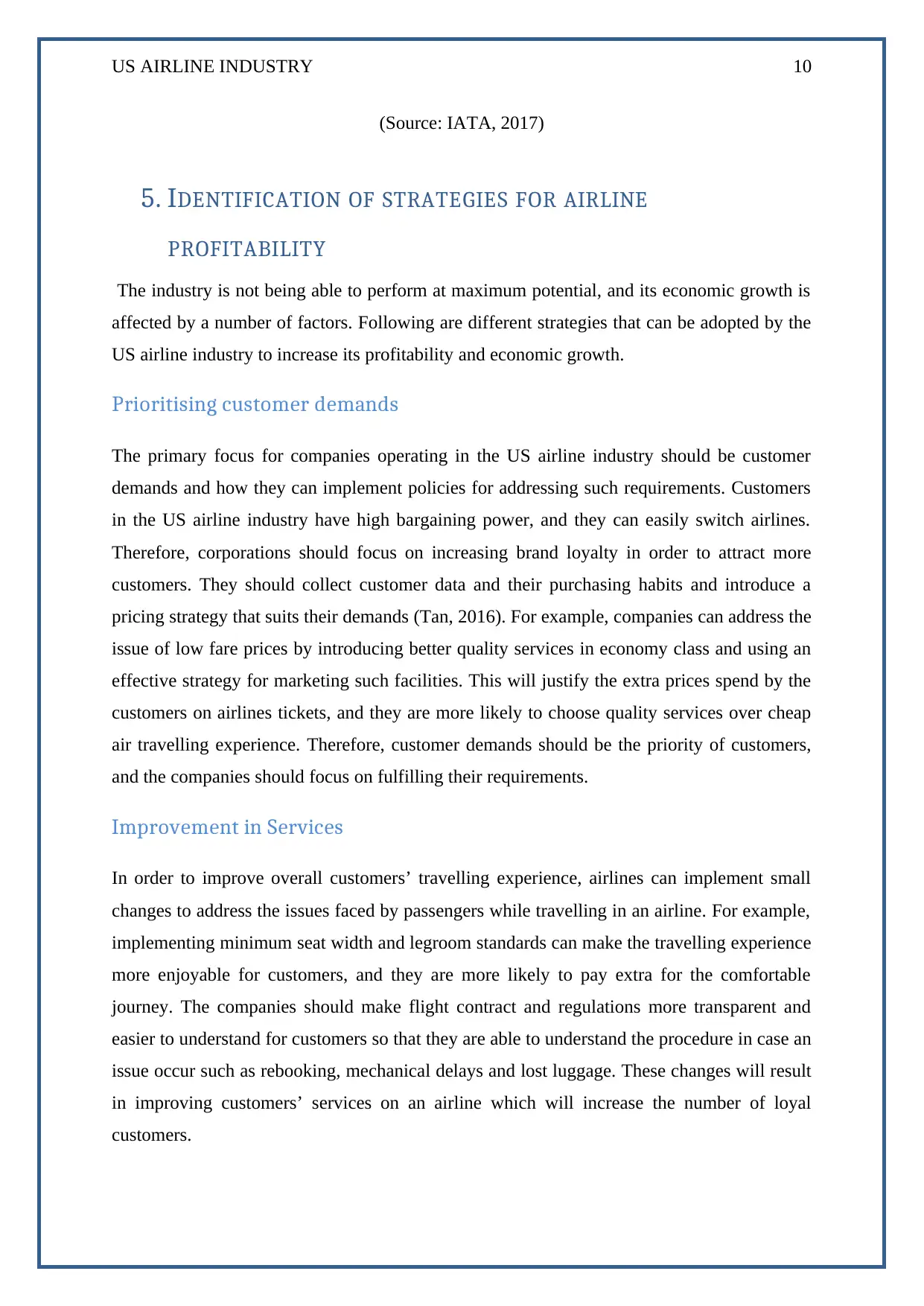
US AIRLINE INDUSTRY 10
(Source: IATA, 2017)
5. IDENTIFICATION OF STRATEGIES FOR AIRLINE
PROFITABILITY
The industry is not being able to perform at maximum potential, and its economic growth is
affected by a number of factors. Following are different strategies that can be adopted by the
US airline industry to increase its profitability and economic growth.
Prioritising customer demands
The primary focus for companies operating in the US airline industry should be customer
demands and how they can implement policies for addressing such requirements. Customers
in the US airline industry have high bargaining power, and they can easily switch airlines.
Therefore, corporations should focus on increasing brand loyalty in order to attract more
customers. They should collect customer data and their purchasing habits and introduce a
pricing strategy that suits their demands (Tan, 2016). For example, companies can address the
issue of low fare prices by introducing better quality services in economy class and using an
effective strategy for marketing such facilities. This will justify the extra prices spend by the
customers on airlines tickets, and they are more likely to choose quality services over cheap
air travelling experience. Therefore, customer demands should be the priority of customers,
and the companies should focus on fulfilling their requirements.
Improvement in Services
In order to improve overall customers’ travelling experience, airlines can implement small
changes to address the issues faced by passengers while travelling in an airline. For example,
implementing minimum seat width and legroom standards can make the travelling experience
more enjoyable for customers, and they are more likely to pay extra for the comfortable
journey. The companies should make flight contract and regulations more transparent and
easier to understand for customers so that they are able to understand the procedure in case an
issue occur such as rebooking, mechanical delays and lost luggage. These changes will result
in improving customers’ services on an airline which will increase the number of loyal
customers.
(Source: IATA, 2017)
5. IDENTIFICATION OF STRATEGIES FOR AIRLINE
PROFITABILITY
The industry is not being able to perform at maximum potential, and its economic growth is
affected by a number of factors. Following are different strategies that can be adopted by the
US airline industry to increase its profitability and economic growth.
Prioritising customer demands
The primary focus for companies operating in the US airline industry should be customer
demands and how they can implement policies for addressing such requirements. Customers
in the US airline industry have high bargaining power, and they can easily switch airlines.
Therefore, corporations should focus on increasing brand loyalty in order to attract more
customers. They should collect customer data and their purchasing habits and introduce a
pricing strategy that suits their demands (Tan, 2016). For example, companies can address the
issue of low fare prices by introducing better quality services in economy class and using an
effective strategy for marketing such facilities. This will justify the extra prices spend by the
customers on airlines tickets, and they are more likely to choose quality services over cheap
air travelling experience. Therefore, customer demands should be the priority of customers,
and the companies should focus on fulfilling their requirements.
Improvement in Services
In order to improve overall customers’ travelling experience, airlines can implement small
changes to address the issues faced by passengers while travelling in an airline. For example,
implementing minimum seat width and legroom standards can make the travelling experience
more enjoyable for customers, and they are more likely to pay extra for the comfortable
journey. The companies should make flight contract and regulations more transparent and
easier to understand for customers so that they are able to understand the procedure in case an
issue occur such as rebooking, mechanical delays and lost luggage. These changes will result
in improving customers’ services on an airline which will increase the number of loyal
customers.
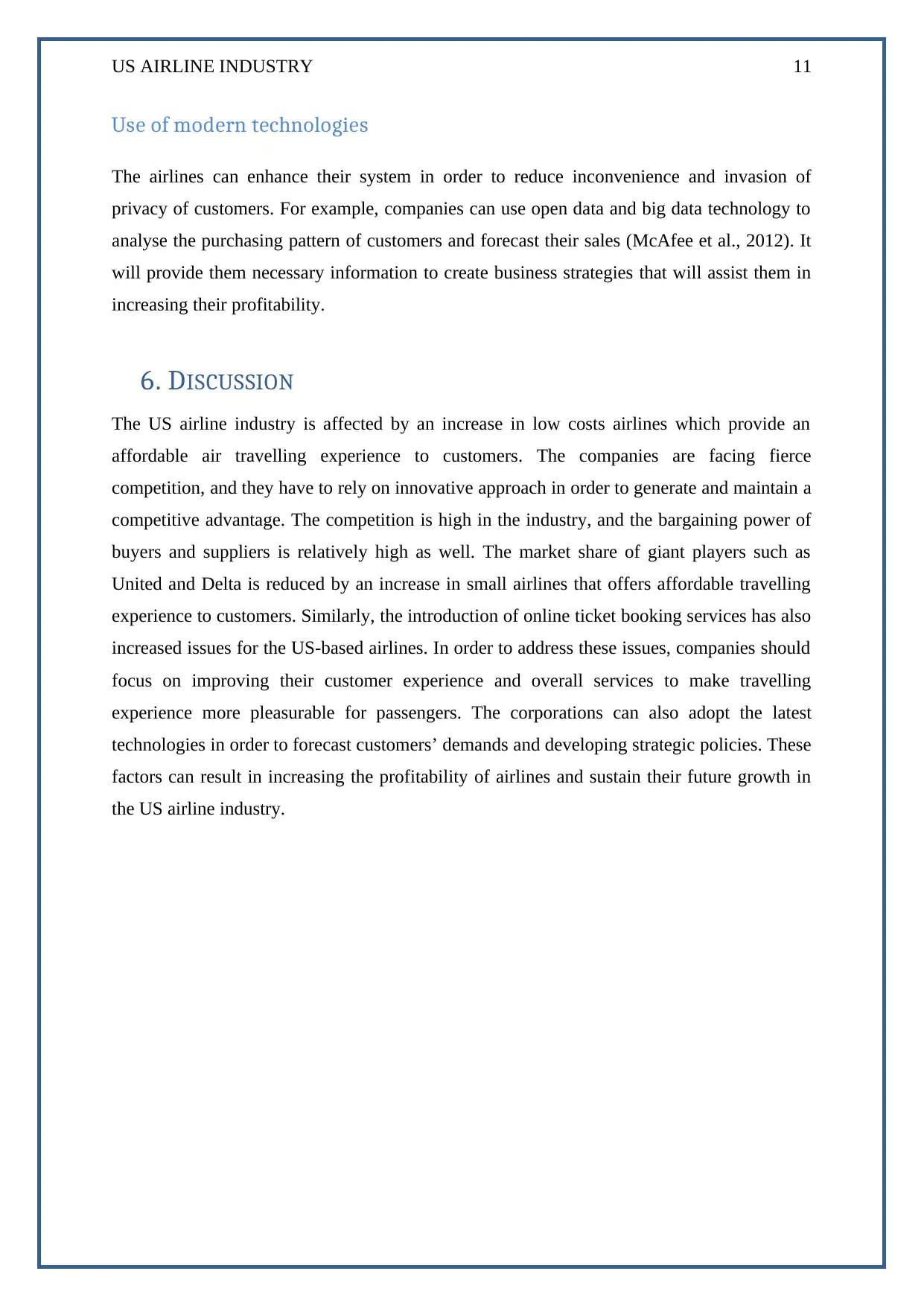
US AIRLINE INDUSTRY 11
Use of modern technologies
The airlines can enhance their system in order to reduce inconvenience and invasion of
privacy of customers. For example, companies can use open data and big data technology to
analyse the purchasing pattern of customers and forecast their sales (McAfee et al., 2012). It
will provide them necessary information to create business strategies that will assist them in
increasing their profitability.
6. DISCUSSION
The US airline industry is affected by an increase in low costs airlines which provide an
affordable air travelling experience to customers. The companies are facing fierce
competition, and they have to rely on innovative approach in order to generate and maintain a
competitive advantage. The competition is high in the industry, and the bargaining power of
buyers and suppliers is relatively high as well. The market share of giant players such as
United and Delta is reduced by an increase in small airlines that offers affordable travelling
experience to customers. Similarly, the introduction of online ticket booking services has also
increased issues for the US-based airlines. In order to address these issues, companies should
focus on improving their customer experience and overall services to make travelling
experience more pleasurable for passengers. The corporations can also adopt the latest
technologies in order to forecast customers’ demands and developing strategic policies. These
factors can result in increasing the profitability of airlines and sustain their future growth in
the US airline industry.
Use of modern technologies
The airlines can enhance their system in order to reduce inconvenience and invasion of
privacy of customers. For example, companies can use open data and big data technology to
analyse the purchasing pattern of customers and forecast their sales (McAfee et al., 2012). It
will provide them necessary information to create business strategies that will assist them in
increasing their profitability.
6. DISCUSSION
The US airline industry is affected by an increase in low costs airlines which provide an
affordable air travelling experience to customers. The companies are facing fierce
competition, and they have to rely on innovative approach in order to generate and maintain a
competitive advantage. The competition is high in the industry, and the bargaining power of
buyers and suppliers is relatively high as well. The market share of giant players such as
United and Delta is reduced by an increase in small airlines that offers affordable travelling
experience to customers. Similarly, the introduction of online ticket booking services has also
increased issues for the US-based airlines. In order to address these issues, companies should
focus on improving their customer experience and overall services to make travelling
experience more pleasurable for passengers. The corporations can also adopt the latest
technologies in order to forecast customers’ demands and developing strategic policies. These
factors can result in increasing the profitability of airlines and sustain their future growth in
the US airline industry.
⊘ This is a preview!⊘
Do you want full access?
Subscribe today to unlock all pages.

Trusted by 1+ million students worldwide
1 out of 16
Related Documents
Your All-in-One AI-Powered Toolkit for Academic Success.
+13062052269
info@desklib.com
Available 24*7 on WhatsApp / Email
![[object Object]](/_next/static/media/star-bottom.7253800d.svg)
Unlock your academic potential
Copyright © 2020–2025 A2Z Services. All Rights Reserved. Developed and managed by ZUCOL.





